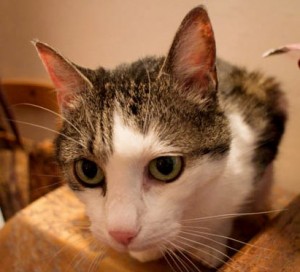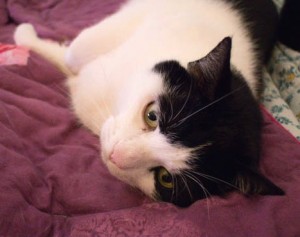I’ve been thinking about giving curcumin to my cats for a long time, but I didn’t have any powder until recently. Then, while I was in the U.S. this past summer, I managed to buy some C3 Complex powder…no additives. Purrfect. And so I’ve been mixing curcumin with their wet food twice a day for the past couple of weeks now.
Here are my reasons for giving them curcumin, aside from the main, obvious one—that is, to keep them as healthy as possible for as long as possible:
 Case no. 1. Puzzola, our eldest (12 years old), was diagnosed with hyperthyroidism last spring. Luckily, she’s at an early stage of this disease. She has lost some weight (that seems to have stopped, though), has a big appetite and is a bit restless, which are all signs of this condition. However, she doesn’t have any other symptoms, as far as I can tell: her fur is soft and silky, she’s not cranky, depressed or aggressive, and so on.
Case no. 1. Puzzola, our eldest (12 years old), was diagnosed with hyperthyroidism last spring. Luckily, she’s at an early stage of this disease. She has lost some weight (that seems to have stopped, though), has a big appetite and is a bit restless, which are all signs of this condition. However, she doesn’t have any other symptoms, as far as I can tell: her fur is soft and silky, she’s not cranky, depressed or aggressive, and so on.
Following our vet’s advice, we’ve been treating her with a conventional drug…a pill that she has to take twice a day. We’ve been mixing it with her wet food. No problems, luckily (= she’s the one who can smell a pulverized antibiotic even inside a mixture of the smelliest anchovies and sardines…!)…
Note: I did some research on this topic and found that curcumin has been studied in connection with hyperthyroidism (in rats)…Even though Puzzola is definitely NOT a rat, Stefano and I decided to give it a try…
 Case no. 2. Piccolo. He’s our nine-year-old, black and white male. In spite of his name (“piccolo” means “small” in Italian…We gave him this name because he was indeed very small when we adopted him, as a result of a serious infection that almost killed him), he’s a big boy who weighs about 9 kilograms or 20 pounds and loves to wolf down not only his food but everybody else’s, too. So, over the years, in spite of our efforts to curb his appetite, he’s gotten a bit heavy. We finally gave up on diet food, deciding that it was too stressful to put him on a diet…too stressful for him AND for us…plus our open-space floor plan makes putting only one cat on a diet virtually impossible…Interestingly enough, he’s now much less obsessed with food, which means that he is eating less now that dry food is available all the time…
Case no. 2. Piccolo. He’s our nine-year-old, black and white male. In spite of his name (“piccolo” means “small” in Italian…We gave him this name because he was indeed very small when we adopted him, as a result of a serious infection that almost killed him), he’s a big boy who weighs about 9 kilograms or 20 pounds and loves to wolf down not only his food but everybody else’s, too. So, over the years, in spite of our efforts to curb his appetite, he’s gotten a bit heavy. We finally gave up on diet food, deciding that it was too stressful to put him on a diet…too stressful for him AND for us…plus our open-space floor plan makes putting only one cat on a diet virtually impossible…Interestingly enough, he’s now much less obsessed with food, which means that he is eating less now that dry food is available all the time…
But let’s get to the important part of his story: last month I noticed that he wasn’t jumping onto the dining room table anymore. Now, Piccolo has always “joined” us for dinner. I mean, he has always curled up at the other end of the table in order to keep us company while we eat…
Then it struck me that he hadn’t been jumping onto the high part of the kitchen counter, either…this is where Pinga has her bowl (it’s a ledge above the counter). Piccolo loves to be up there, since it’s the highest spot in our open kitchen-dining room area = the purrfect place for a dominant kitty to keep tabs on the other cats…and to bump foreheads with me 🙂 …How had I not noticed that before???
Last but not least, Piccolo has also been having a bit of trouble hoisting himself onto our bed. He jumps just enough to get his head above the mattress, then he pulls himself up the rest of the way, digging his claws into the cover for extra help. He’s never done that before.
So I began watching him more closely, and I noticed (horror) that he was walking a bit…funny. It looked as though he might be in a bit of pain. Arthritis? Time to intervene…
 Case no. 3. Prezzemolo, our youngest cat (1.5 years old, I think, by now), the one who came from the cat shelter, has always been a bit sickly, unfortunately. You may remember that he had a bit of a difficult time last fall, right after we adopted him…he came to us with a variety of ailments…He’s gotten over most of them, but he still has a chronic cold thing caused by a stubborn virus. Our vet thinks he’ll have this condition for the rest of his life. It means that during the winter months in particular, even though our cats are indoor cats, this chronic condition gets worse…
Case no. 3. Prezzemolo, our youngest cat (1.5 years old, I think, by now), the one who came from the cat shelter, has always been a bit sickly, unfortunately. You may remember that he had a bit of a difficult time last fall, right after we adopted him…he came to us with a variety of ailments…He’s gotten over most of them, but he still has a chronic cold thing caused by a stubborn virus. Our vet thinks he’ll have this condition for the rest of his life. It means that during the winter months in particular, even though our cats are indoor cats, this chronic condition gets worse…
Main symptom: he sneezes violently, and his…uhm, let’s see if I can find a polite way to put this…uff, no, I cannot!…and, er, his snot shoots out of his nose as violently as hot water and steam from a geyser, landing all over the place–our walls (btw, the snot dries so quickly that we usually don’t get it off in time…Result: the walls are now all speckled…Yeah, I know this is revolting…SORRY! 😉 ), the other cats, any surface such as the kitchen counter…and on us, too, if we don’t get out of the way in time. Yeah, yucky, I agree. A lot of this stuff also sticks to his face, and he licks it off. Super gross! Okay, okay, way too much information! I think you get the idea… 😉
I’ve been giving him vitamins, but so far nothing has worked. By the way, he doesn’t act like a sickly cat. On the contrary, he’s super active…adorable, playful, affectionate, happy, and so on…It’s just that he has his sneezy-snotty “moments.” We can all live with that, but it would be nice for him to have a normal life…
Okay, now, based only on my own observations (and Stefano’s), here are the results of administering curcumin to the cats in this short period:
General observations:
- I haven’t noticed ONE single pool of vomit (hairball-caused, etc …). We usually have at least one per week. And we’ve been through periods of one per day, too. Could it be the curcumin?
- In the pre-curcumin period, Pinga (three years old) would almost never come downstairs to have breakfast. She is also a super finicky eater: she loves tuna but little else. How many times has she walked away from her food? Too many to count. Well, that has changed. Ever since I began mixing curcumin into their wet food, she’s been the first cat downstairs in the morning. No kidding. She sits on the edge of the counter and waits impatiently for her food, tapping me on the arm and chirping if I seem too slow (hey, I feed the cats BEFORE coffeezzzzz! 😉 ). I’ve never seen anything like it. Not with her…
- All the cats are eating their curcumin-enriched food eagerly…I’ve never seen them lick their bowls clean like that. I admit, even I am surprised.
And now, in order of appearance and age:
- Puzzola: hard to tell if there have been any changes until she has blood tests (we’re going to meet with the vet next week). She seems absolutely fine, though, and perhaps less agitated, yes, but I can’t tell if anything else is going on with her.
- Piccolo: he has recently begun, slowly, to jump onto the dining room table. The first time this happened, I almost wept with joy (I’d seen him try and fall so many times…broke my heart…In case you were wondering, whenever he fell, we’d pick him up and put him on the table…). He still hasn’t tried jumping onto the high counter, though; I think he’s still scared of not making it. I’ll see what I can do about that, at some point. One step at a time…
- Prezzemolo: his is the most noticeable change. He isn’t sneezing as much! No big snot episodes/wall decorating in the past week. No kidding. This is a huuuuuge improvement. Now, would this have happened even without curcumin? I have no proof, of course, but my instinct tells me “no,” especially since I know how snotty and sneezy he was last winter (all winter!) and also in the pre-curcumin weeks, which is when the weather started getting cooler over here…
If I observe anything else, good or bad, I’ll let you know…For now, all is well!
The experiment continues…
P.S. Interesting note: I recently found a curcumin product (for sale) for cats and dogs. Its main ingredient is C3 Complex, so I asked myself, why not use that directly? Plus, this way, I’m not giving them anything BUT the powder…no additives, that is, as I mentioned previously…
I haven’t posted for awhile for a lot of reasons, one of them being that I was re-establishing myself in WA State, closer to the relative with MM. The news on that front is “stability” and so far, so good.
I adopted a shelter kitty who had been incarcerated for 1/3 of his furry life… adopted out once and then returned when he didn’t fit in, or whatever the issue was, and “being returned” is nearly a death sentence (unless it is fortunate to be returned to a no kill shelter) because it goes on the record sheet. Now, after six months with me, he is coming out of his protective shelter shell and sleeps all curled up next to me every night, talks a lot and is starting to be quite kittenish racing about and acting like a normal wacky cat.
It was always my plan to introduce another cat into the mix, a female, I thought. And I went to the shelter to get a cat that had been there for a few months, but the shelter manager refused to let me have that particular cat because she already had a record of two returns and she felt the cat had behavioral problems and that I would end up bringing her back. Frustrated I waited and wondered if I should get another cat.
Today when I went back, the lead volunteer (knowing the situation) introduced me to a 5-month old all black female who put her little cat paws around my neck and the next thing I knew I was bringing her home. So here’s why I’m writing YOU….
It is best, I know, to keep them separated, but when is it enough? How do I interpret cat messages to introduce them? I have let the older, house-owning cat have the run of the place and put the newest one in a room at the farther end. She is frightened and wants to be in my arms, purrs like crazy, but I am nervous about bringing them together too early and having a negative resistance that lasts a long time.
Speak to me, O Cat-Oz person… purrrrr ty please!
Hey Sandy, glad you’re “back”! 🙂
That’s really sad, I mean about the kitty that was returned twice. I wouldn’t be surprised if she had some mental issues as a result. But I’m happy that you managed to save at least one unlucky kitty… 🙂
As for how long to wait before introducing them, that’s a good (impossible!) question. Sometimes cats get along immediately…sometimes they will hate each other for life (happened to us once, but we just threw the cats together, not knowing any better…Then our “aggressive” cat got sick and died…And that’s when I began doing research on proper cat introduction etiquette). Luckily for you, there is a lot of info online. Just google how to introduce a new cat etc.
Now, if the new cat is healthy (no FIV etc.), then IMO you don’t need to wait too long. If she’s nervous, though, give her time to calm down. A week? Too long?
During that preparatory time, Stefano and I sleep apart (one of us with the new kitty, the other with the resident cats…can you get a friend to sleep over for a few nights?).
We rub a towel over the new kitty, then over the resident cats (they love that! Uhm, not…), then again over the kitty, over the cats…This mingles their odors and makes the new kitty’s odor more acceptable to the others.
The day before the official meeting, you want to lock up the resident cat (cats) in one room and let out the new kitty. Let the new kitty explore the house and leave her odor everywhere for the other one to smell later on. There is another reason: this way, the new kitty can explore on her own and find out where things are. Especially the cat litter boxes. She will be very nervous at first…that’s normal. Just make cooing sounds to her and bat your eyes to reassure her. And follow her everywhere, so she feels safe.
When they meet, they will hiss and growl…no worries. I doubt there will be anything more than that (have they both been “fixed”? Probably).
One thing that a blog reader taught me is to bring out a toy (like the feather wand, or just some string with something attached at one end), and play with both cats to reduce the initial tension, especially if things get a bit heated. I’ve never tried that. I’ve just let them figure things out on their own (once I’ve introduced them properly, I mean). I mean, I don’t intervene…
Oh, and one more thing. Some say to put the new kitty in the cat carrier and set her down in the middle of the living room, e.g. I don’t like that idea. What we do is open the new kitty’s door a little bit and let the cats see each other and perhaps touch noses (and hiss and growl). Then we give them a rest before trying again. Make cooing sounds, letting them know things are ok.
I’m sure I’ve forgotten a million things (you could also get some Feliway, but I’m not sure that really works)…So check online and see if there are any other tidbits…
Good luck, and let me know how things go. 🙂
I had an interesting conversation yesterday with my neighbour who has lymphoma. She had been chatting to her consultant about curcumin. The consultant was very enthusiastic. It would seem that the consultant’s horse had been very badly injured – no bones broken – but a lot of internal injuries and her vet had said that this was now the end of the horse’s active life, especially from a riding point of view. The consultant decided to try curcumin and added the powder to the horse’s feed. The vet was amazed 4 months later as the horse was completely healed and fit for any purpose she wanted to use it for! The only odd symptom – her light mane had turned orangey/yellow.
Thank you, Margaret, for the info… I introduced them last night and they spent the whole night jumping up and off my bed, playing chase and chicken and a bunch of other cat games! I didn’t get much sleep, so they are sleeping apart for a few days until the excitement wears off a bit. So far, so good. It seems as if the resident cat, Maxie, is beginning to adapt to the idea of a ‘pal’ but I’m not pushing him. Cleopurrtra (AKA mew-mew) likes being where I am, and is a snuggler, wrapping her paws around my neck whenever she can. I recently suggested curcumin to a fellow cat owner who is struggling with hyperthyroidism. She said she’d try it.